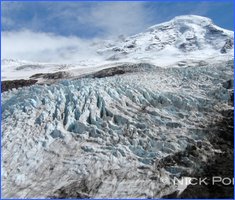Crevasse Rescue & Glacier Travel Course 3-Day
Don't have 5-days to take our complete glacier mountaineering course, but simply want to gain the skills needed to be a competent member of a group led by a more experienced leader? Our crevasse rescue and glacier travel course covers part 1 of our 5-day glacier mountaineering course and can be followed up with part 2 of that same course at a later date.
This course takes place on the easily accessible North side of Mt. Baker, the best spot in the state of Washington to practice your crevasse rescue, glacier travel, and cramponing skills on a complex glacier with features such as crevasses and seracs.
Skills Covered - Glacier Mountaineering Pt.1
- Crevasse Rescue
- (2:1, 3:1, 5:1, and 6:1)
- Climbing Rope Management
- tying in, laying out rope, tying off excess line
- Belaying and Ascending Fixed Lines
- mechanical ascenders, prussics, reversos/guide ATC's
- Knots and Hitches
- figure 8, butterfly, prussic, autoblock, clove hitch, munter hitch, munter mule
- Self-Arrest & Team Arrest
- Rope Travel on Glaciers
- proper interval, using knots in ropes, making corners
- Rope Mangement
- coiling, stacking, and belaying
- Snow & Ice Anchors
- Ice screws, v-threads, pickets, bollards
- Crampon Technique for Ascending and Descending
- french technique, front pointing, clearing crampons
- How to Dress for Life in the Mountains
- clothing selection and layering
- Leave No Trace
Itinerary: 3-day Crevasse Rescue - Glacier Travel Course
Day 1: Meet your guide at the Ranger Station in Glacier, WA at 9:00 am for group check-in, equipment check, and final packing. We focus on keeping packs as light as possible while remaining prepared for emergencies or poor weather. Once we are packed up we drive a short distance to the Heliotrope trailhead at 3700' and hike to our basecamp at 5000' This camp is lower than the camp we use for Coleman-Deming Climbs and puts us closer to the training area, generally on the lower Coleman Glacier. In camp we will review solid camp construction and spend the evening cooking and covering the basics knots and hitches that we will use for the next two days of training.
Day 2: If the weather cooperates we will get an early start and make sure we have a full-day out on the glacier. We will start on a moderate glacier and talk about glaciology and the forces that create icefalls, crevasses, and seracs. We then and cover how to properly use an ice-axe, dial in our crampon technique, and finally tie it all together with rope travel. In the afternoon we will go over snow and ice anchors and work on getting to the point where we have the ability to build a bomber anchor for crevasse rescue. We will cap the day off with ascending fixed lines using devices such as mechanical ascender as well as simpler systems such as prussics, the autobock, or the Klemheist. There is usually time to climb some steeper snow or ice and work on front-pointing. Following dinner your guide will begin to introduce some of the basic concepts of crevasse rescue.
Day 3: Today will focus entirely on crevasse rescue. To find a suitable crevasse we will need to travel through glacier terrain and can reinforce the glacier travel skills we developed the day before. This training works best in a real crevasse as it allows you to feel the full weight of the forces involved. We will start with simple systems such as the drop C (2:1), surface C (2:1) and the Z system (3:1). Once these systems are mastered we will move on to more complex systems such as the 5:1 and 6:1. We explain and demonstrate that with increased mechanical advantage you also place more force on your anchor, a factor that must be taken into account when choosing a system to perform a crevasse rescue. All of the training takes place with a second, bomber, back-up line in place to ensure climber safety. There is also time for people to work on their systems for self-extrication. The fixed line portion builds on what we covered the previous day. We will then pack up and head down with the goal of reaching the trailhead in time for people to make the drive back to the city with a few hours to spare in the evening.






